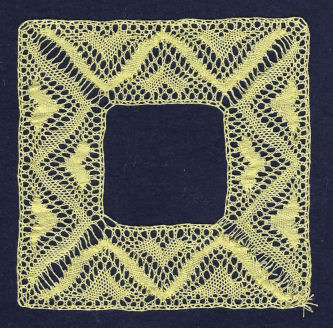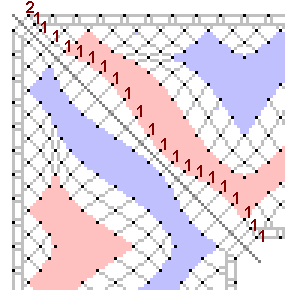


Pattern:

Bobbins: 23 pairs
Style: Torchon with variable grid
Stitches:
half stitch
cloth stitch
cloth stitch and twist
plait
twist pair
Details:
cloth zigzag (red)
half stitch zigzag (blue)
cloth heart (red)
half stitch heart (blue)
Torchon ground (grey)
twisted footside (grey)
corners
how to start and finish
Description:
Follow the links above for explanation of how to work the different parts of the lace. This is a square mat with a hole in the centre, in other words, an edge. It is made up of straight pieces of lace (with diagonal starts and ends).

The start is along a diagonal, so one pair starts at each pin, and two at the edge, with extra for the passives. Above, I have marked the position of the false pins. There are two pairs at the top. When, later on, you turn the pillow, there will still be two pairs at the top. You can work these in a plait, just to get them to the start of the next quarter.
Click here for how to finish an edge. Remember to leave the first two rows of pins in the pattern in place, and push them up to their heads. Remove other pins to reuse at the end as usual. You will find that if you don't, the threads will catch on the pins as you turn the pillow.
This type of shape is made up of 4 straight pieces. You work down to a dark grey line, then turn the pillow 90° to work the next straight piece. So you must use a pillow that you can turn and work from any angle, such as a cookie pillow.
Click here to see how to sew this onto fabric to make a mat. You could extend the pattern to trim a larger mat.
This is designed on a variable grid. This distorts the straight lines of the zigzags and hearts into curves. These are pleasing to look at, but can be tricky to work, since the pin holes are not quite where you expect them, and some are very close together. I had to do quite a bit of undoing and redoing to work this!
© Jo Edkins 2017 - return to lace index